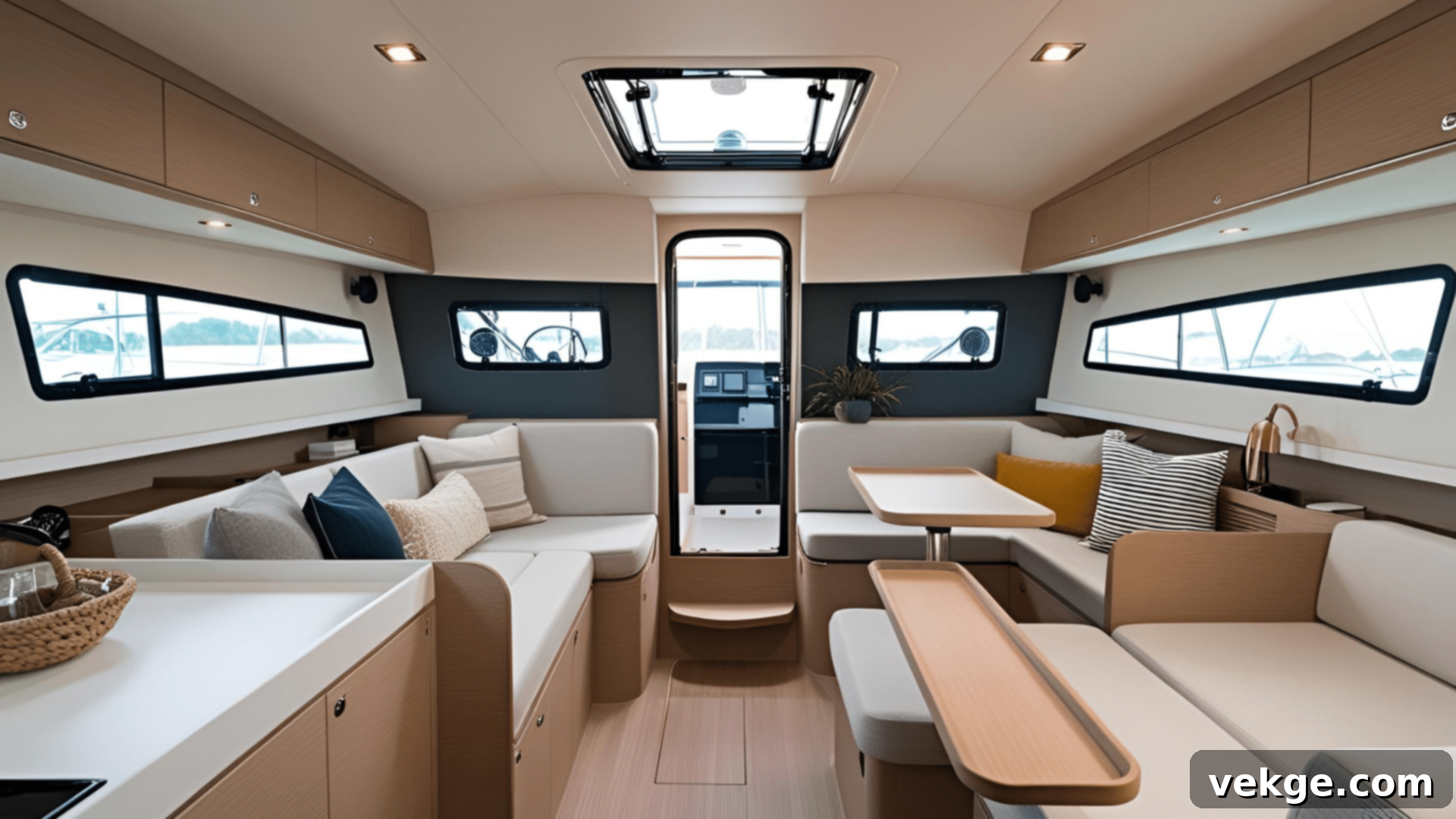Transform Your Boat Interior: Expert Tips for a More Spacious & Lighter Feel
The interior of a boat can often feel dark, cramped, and confining, making extended stays or even short trips less enjoyable than they should be. However, even with limited space, a few strategic design changes can dramatically alter the perception of your boat’s cabin, transforming it into a more open, inviting, and comfortable environment. By focusing on smart choices in color, lighting, storage solutions, and materials, you can enhance the feeling of space and brightness without undertaking extensive or costly renovations. These thoughtful adjustments can significantly improve your boat’s perceived size and overall livability, allowing you to fully appreciate every moment spent on the water, whether on a long voyage or a relaxing weekend getaway.
Key Elements for a Lighter and More Spacious Boat Interior
Creating an open and airy feel in a boat’s interior, despite its inherent space limitations, is achievable through deliberate design choices. The secret lies in a harmonious blend of practical solutions and aesthetic considerations. Smart decisions regarding color palettes, optimized lighting, carefully selected materials, and efficient organization are the cornerstones of a truly expansive-feeling marine living space.
Organization and Smart Storage Solutions
A clutter-free environment is paramount for making any small space feel larger, and a boat interior is no exception. Every item out of place can contribute to a sense of chaos and constriction. Implementing smart storage solutions is crucial to maximizing the available area and maintaining an organized, visually appealing cabin. Think beyond basic cabinets: hidden compartments under berths, convertible furniture that serves multiple purposes (like an ottoman with storage or a dining table that folds away), wall-mounted racks for often-used items, and vertical storage units can significantly increase your usable space. Storing items out of sight not only reduces visual clutter but also makes the boat feel cleaner, more orderly, and consequently, much more spacious and tranquil.
Strategic Color Selection
The power of color in interior design, particularly in compact spaces, cannot be overstated. Choosing a light paint color for walls, ceilings, and large surfaces is one of the most effective ways to make a boat interior feel expansive. Whites, creams, soft pastels, and light grays reflect more natural and artificial light, helping to bounce illumination around the room and visually push back walls. This creates an immediate impression of increased depth and openness. Incorporating reflective surfaces, such as mirrors or subtly glossy finishes, can further amplify this effect by multiplying light sources and adding a sense of limitless space. A cohesive, light-toned color scheme unifies the entire interior, eliminating visual breaks that can make a space feel choppy and small.
Optimized Lighting Solutions
Maximizing natural light is arguably the most impactful way to open up a boat interior. If possible, consider installing larger windows, portholes, or skylights to flood the cabin with daylight. When natural light is abundant, use lightweight, easily retractable curtains or blinds that can be fully opened to allow maximum light penetration. For times when daylight is scarce, a well-planned artificial lighting scheme is essential. Opt for modern LED lighting with adjustable brightness and color temperature (warm vs. cool). Strategically placed task lighting, ambient lighting, and accent lighting can work together to eliminate dark corners, highlight key features, and create a warm, inviting ambiance that enhances the perception of space rather than diminishes it. Up-lighting, for instance, can draw the eye upward, making ceilings feel higher.
Mindful Material Choices
The selection of fabrics, finishes, and textures plays a significant role in fostering a sense of spaciousness and comfort within a boat. For upholstery, cushions, and bedding, gravitate towards light-colored fabrics. These materials, much like light paint, reflect light and contribute to an airy aesthetic. Smooth, sleek finishes on surfaces such as countertops, galley splashbacks, and cabin walls also promote a feeling of openness, as they tend to reflect light uniformly and create an uninterrupted visual flow. Conversely, heavy or dark textures can absorb light and make a space feel heavy. Introduce soft textures through plush, lightweight throws, decorative pillows, or sheer curtains to add comfort and visual interest without overwhelming the limited space. Prioritizing durable, easy-to-clean materials is also practical for the marine environment, ensuring your fresh look lasts.
Easy Ways to Make Your Boat Interior Feel Bigger and Brighter
Improving depth and openness in small spaces, especially aboard a boat, doesn’t require a complete overhaul. Even seemingly minor adjustments can yield significant results. These practical tips focus on leveraging visual tricks and smart design choices to make your marine living area feel more expansive, brighter, and ultimately, more enjoyable.
1. Clear Clutter and Get Organized

One of the quickest and most effective ways to make your boat’s interior feel larger is to remove unnecessary items and implement highly efficient storage systems. Every unorganized item, from stray books to misplaced gear, contributes to visual noise and makes a space feel smaller. By minimizing clutter and utilizing every possible storage opportunity—such as hidden compartments built into benches, multipurpose furniture that doubles as storage, or vertical wall organizers—you create a more streamlined and open environment. A tidy boat not only looks bigger but also feels more peaceful and functional.
- Why it Works: Eliminates visual distractions and physical barriers, preventing overcrowding and making the interior immediately feel larger and more serene.
- How to Implement: Invest in built-in storage, floating shelves, and cabinets. Use baskets, bins, and dividers within existing storage to keep essentials neatly tucked away. Regularly declutter, only keeping what is essential or truly loved aboard.
- Best For: All boats, especially those with limited square footage and a tendency to accumulate gear.
2. Pick a Light Color Scheme
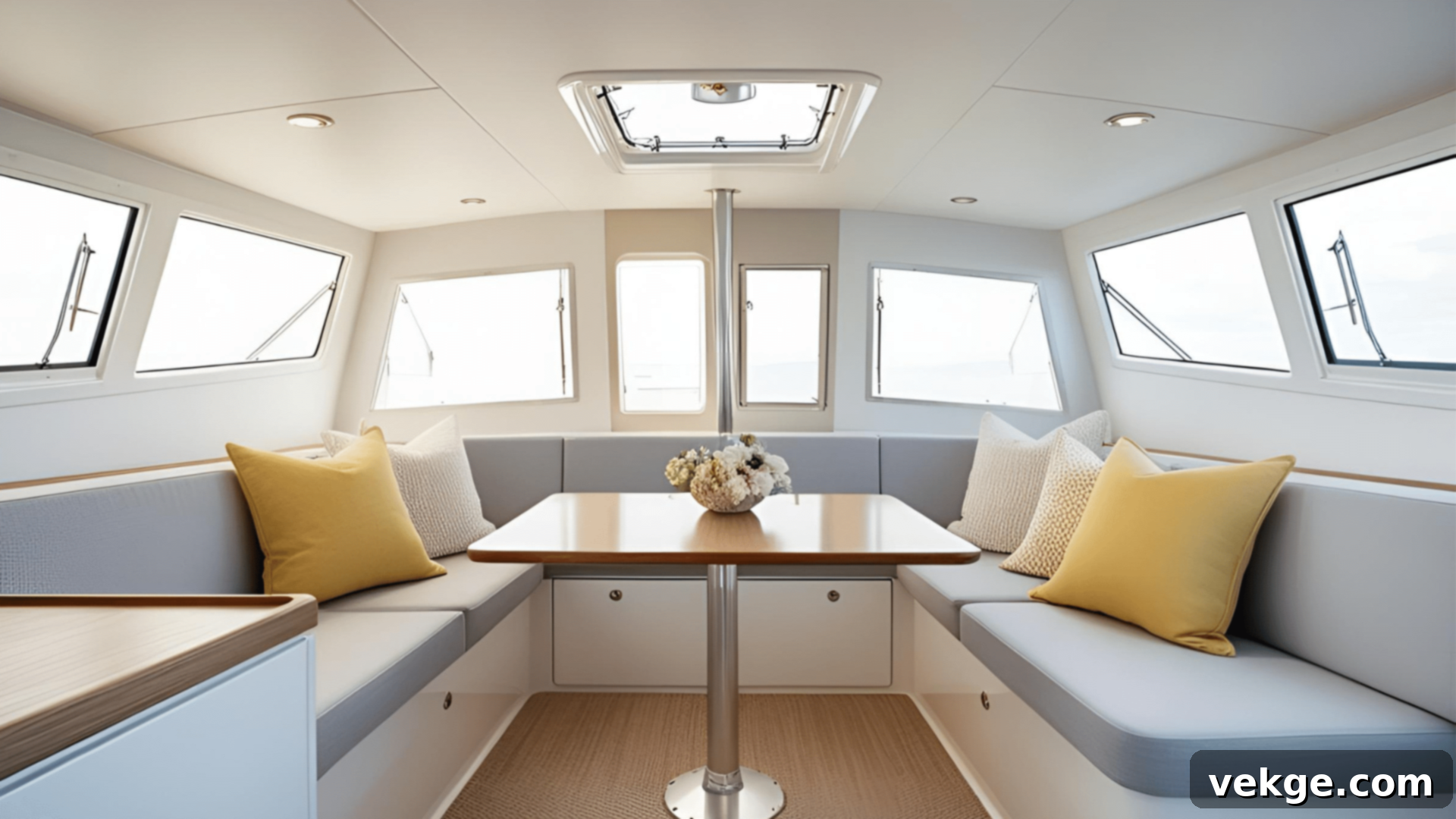
A thoughtfully chosen, cohesive color palette that incorporates light-reflecting shades can profoundly impact the perception of space. Soft whites, gentle grays, pale blues, and serene pastels are excellent choices, as they reflect light rather than absorbing it. This creates an illusion of depth and makes the boundaries of the space seem to recede. A consistent light color scheme throughout the boat unifies the cabin, making it feel more expansive and airy, rather than segmented and small. Avoid stark contrasts that can visually chop up the space.
- Why it Works: Light colors reflect significantly more light, brightening the interior and giving the powerful illusion of a larger, more open space.
- How to Implement: Apply light hues to large surfaces like walls, ceilings, and built-in furniture. Extend the palette to upholstery, linens, and accessories for a harmonious, open feel.
- Best For: Tight spaces that desperately need a bright, spacious, and calming atmosphere.
3. Paint the Walls a Light Color
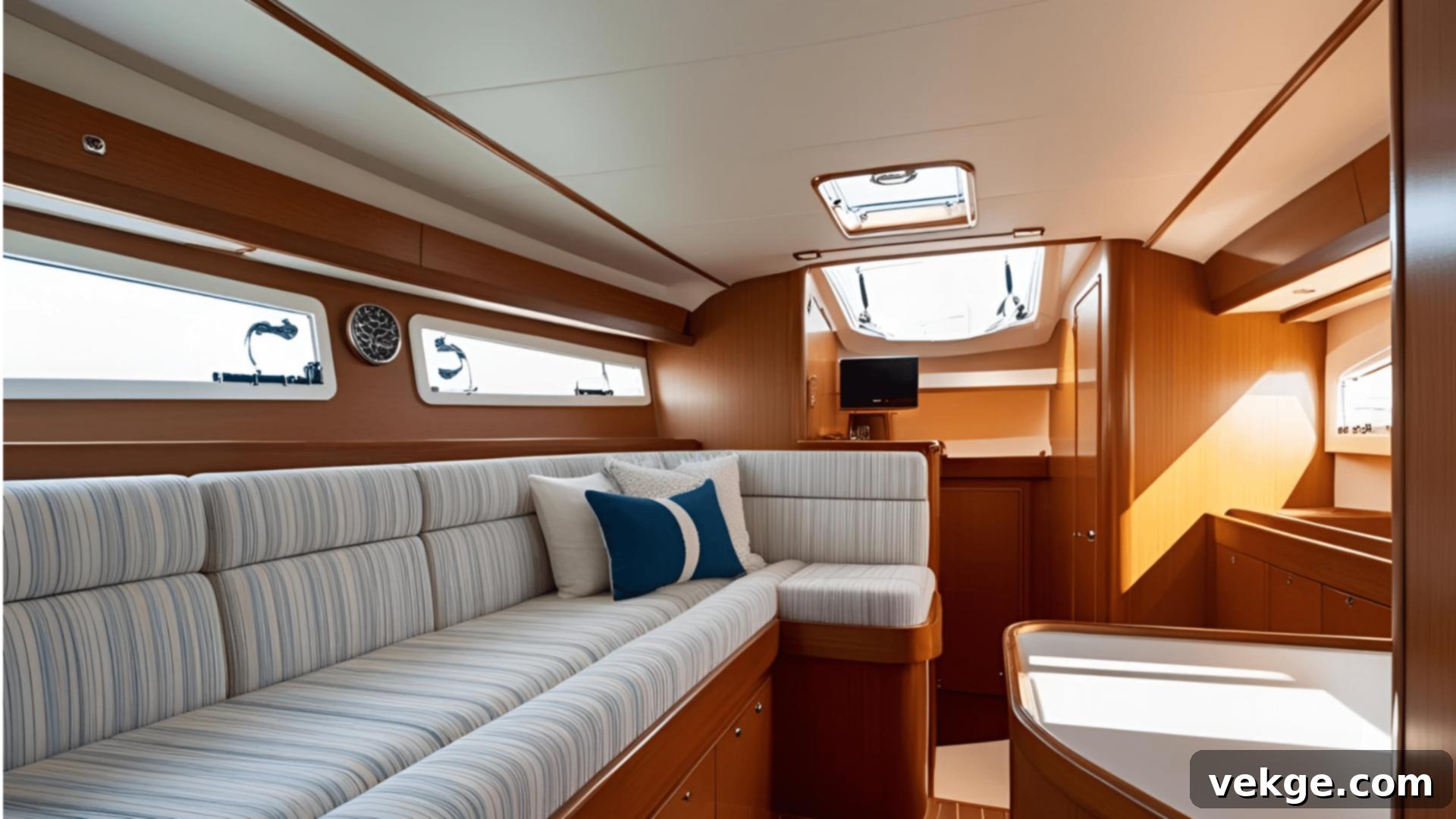
Many older boats feature dark wood paneling or finishes, which, while classic, can absorb light and make the interior feel cave-like. Modifying these dark surfaces with a fresh coat of light-colored paint can drastically transform the perception of space. A soft white, off-white, or pale gray paint will instantly brighten the cabin, reflecting available light and creating a feeling of openness and modernity. Choose marine-grade paints that are durable and resistant to moisture and mildew for a long-lasting finish.
- Why it Works: Light-colored walls instantly brighten the room, make the boundaries appear further away, and create a strong sense of airiness and spaciousness.
- How to Implement: Thoroughly clean, sand, and prime dark wooden or fiberglass surfaces before applying two to three thin coats of a light, reflective marine paint. Ensure proper ventilation during the process.
- Best For: Older boats with heavy, dark wood finishes that feel dated and oppressive.
4. Consider Painting the Ceiling White

Often overlooked, the ceiling can significantly impact how open a space feels. Painting the ceiling white or a very light color helps to create a sense of height, tricking the eye into believing the space is taller than it actually is. A white ceiling reflects ambient light downwards, brightening the entire area and providing the illusion of higher ceilings. This simple change can make a boat’s cabin feel significantly roomier and less claustrophobic, especially in areas with lower head clearance.
- Why it Works: White ceilings recede visually and reflect light, making the space feel taller, more open, and generally brighter.
- How to Implement: Choose a matte or semi-gloss white marine paint for the ceiling. Matte finishes help diffuse light evenly without glare, while semi-gloss is easier to clean. Ensure uniform application.
- Best For: Boats with lower ceiling heights or any cabin where a more open and lofty feel is desired.
5. Select Light-Colored Upholstery
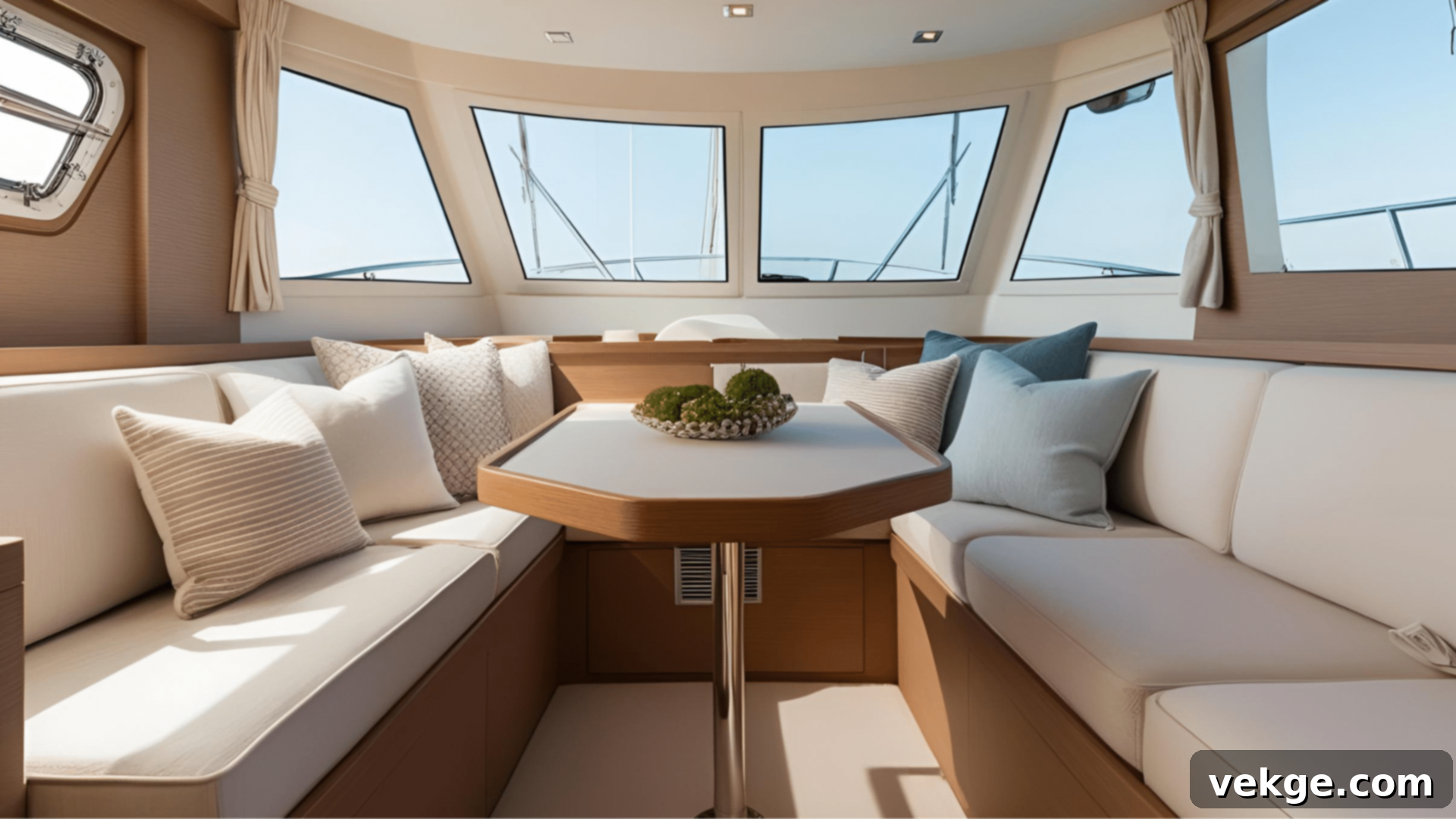
Just like walls and ceilings, your upholstery choices can profoundly influence the perceived size of your boat’s interior. Using neutral and light-colored fabrics for cushions, throws, and seating maximizes space perception. Light-toned upholstery—think beige, light gray, soft blues, or creams—blends seamlessly with the overall light color scheme, preventing visual breaks that can make a space feel smaller. These choices keep the environment calm, elegant, and uncluttered, contributing to an airy and expansive vibe. Choose marine-grade fabrics for durability and ease of cleaning.
- Why it Works: Light tones on furniture and upholstery reflect light, contributing to a more spacious, airy, and cohesive visual environment that doesn’t overwhelm the eye.
- How to Implement: Opt for neutral and light hues like beige, light gray, soft pastels, or white for all upholstery, pillows, and throws. Consider outdoor fabrics for their durability and easy maintenance.
- Best For: Boats with significant seating areas or limited furniture, where upholstery forms a large part of the visual landscape.
6. Play with Texture
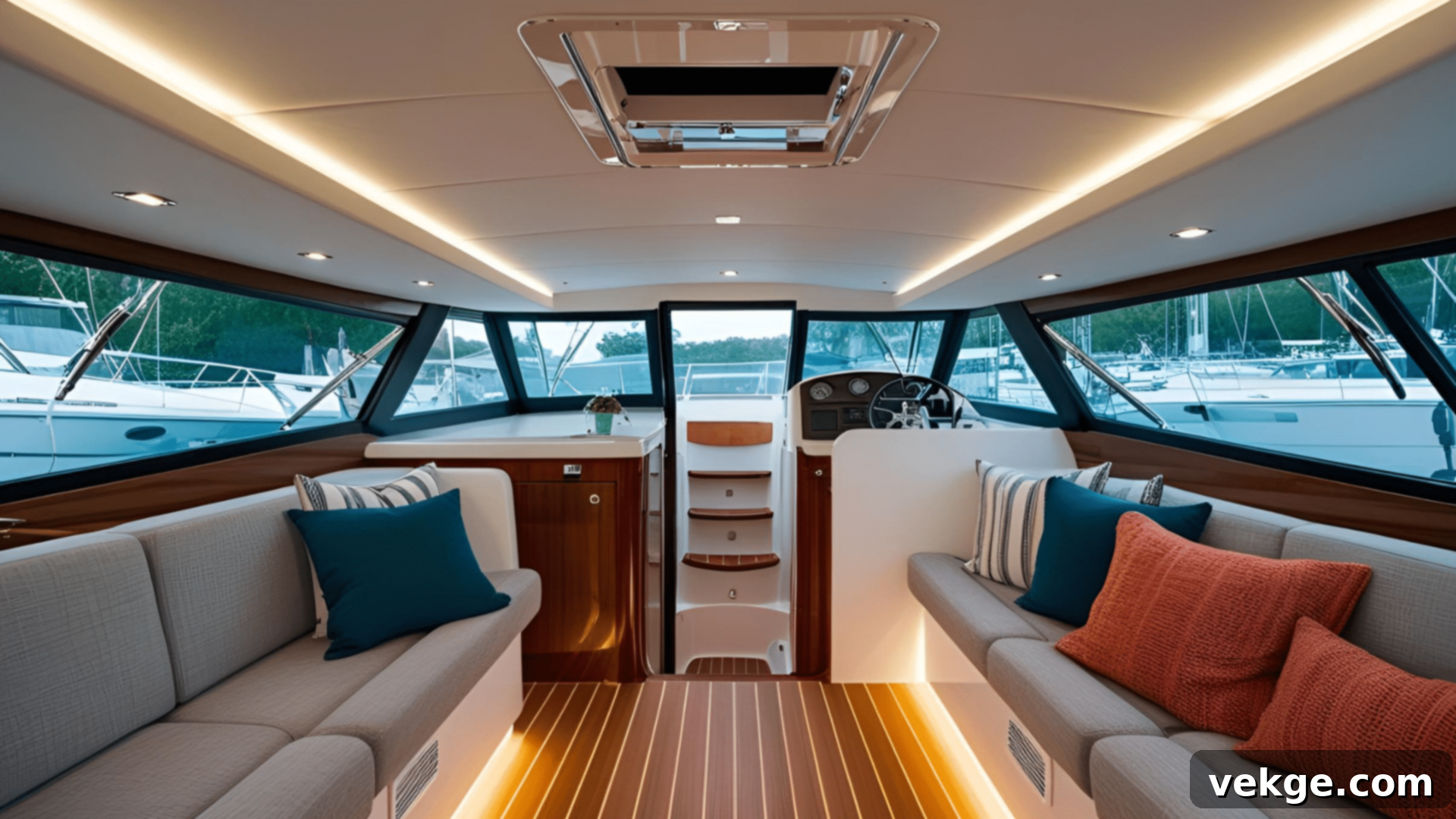
While a light color palette creates the foundation for a spacious feel, introducing a variety of subtle textures can add depth and visual interest without overwhelming the space. Combining smooth, sleek surfaces with softer, tactile textures can create a rich, layered look that adds dimension. For instance, pair smooth, glossy countertops with linen upholstery, or a woven throw with a soft cotton pillow. These variations prevent the space from feeling bland or sterile, adding warmth and sophistication. The key is to keep the textures subtle and harmonious with the light color scheme, ensuring they enhance rather than detract from the sense of openness.
- Why it Works: A mix of textures adds dimension, character, and tactile interest to a room, creating depth without needing to introduce dark colors or bulky items.
- How to Implement: Use a variety of textiles such as linen, cotton, velvet, or subtly patterned fabrics on upholstery, cushions, curtains, and throws. Introduce smooth finishes on tables and walls.
- Best For: Boating interiors needing warmth, character, and tactile interest without sacrificing the light and airy feel.
7. Add Strategic Lighting
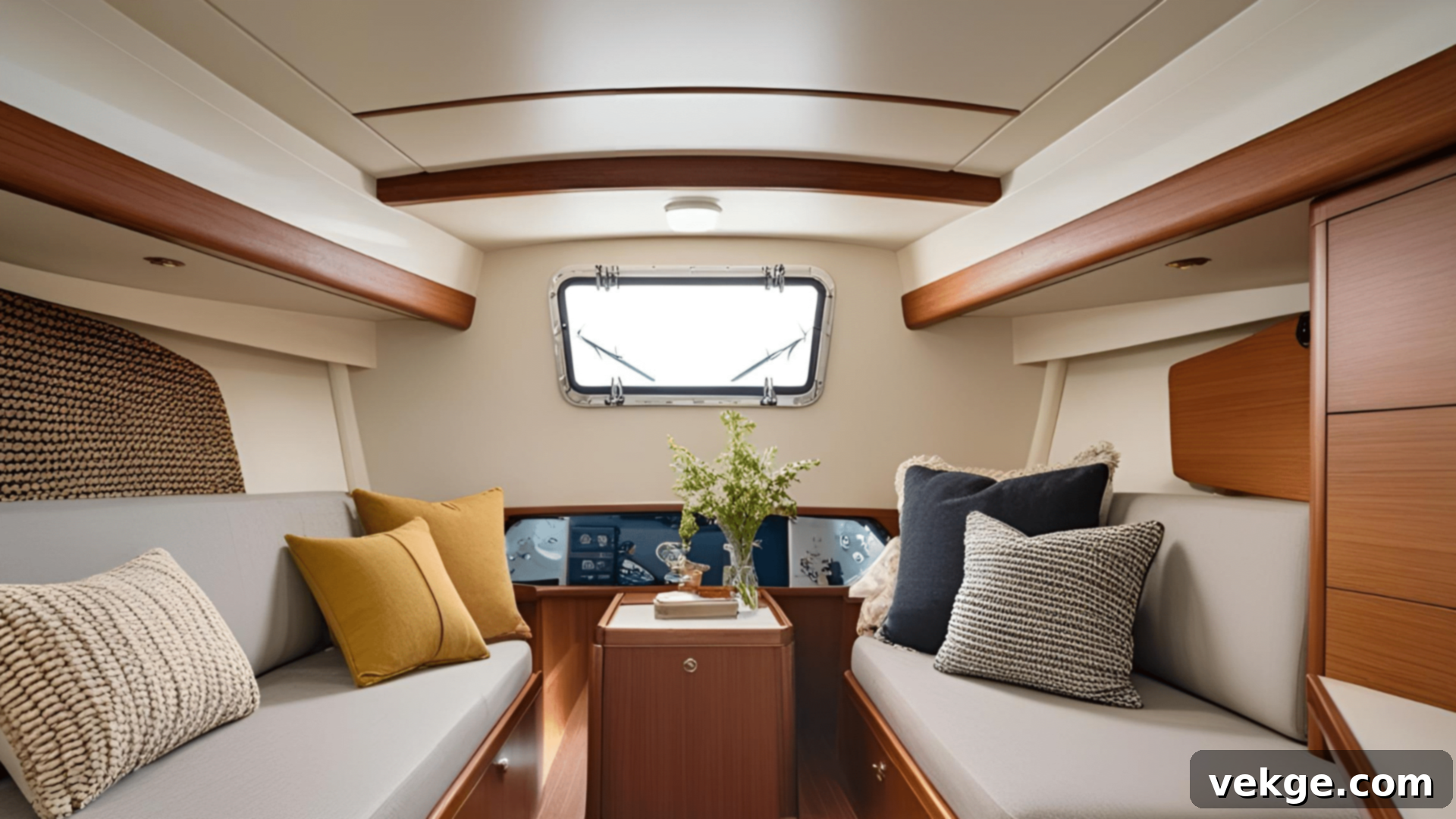
Beyond maximizing natural light, the careful placement of artificial lighting can dramatically influence the perception of space. Install LED strip lights under shelves, along toe kicks, or behind valances to create soft, ambient light that washes surfaces and eliminates harsh shadows. Well-placed light fixtures, such as adjustable spotlights or small sconces, can highlight specific areas or draw the eye upward and outward, making the boat feel bigger and more inviting. Layering different types of lighting—ambient, task, and accent—creates depth and ensures every corner is adequately illuminated, contributing to an overall sense of openness.
- Why it Works: Strategic lighting eliminates dark spots, highlights vertical and horizontal lines, and creates the illusion of more space by extending visual boundaries.
- How to Implement: Install dimmable LED lighting under shelves, inside cabinets, or along the floor to create soft glows. Use adjustable fixtures for task lighting in the galley or at navigation stations.
- Best For: Boats that lack abundant natural light, have dark corners, or require versatile lighting for different moods and activities.
8. Ditch the Curtains (or choose wisely)
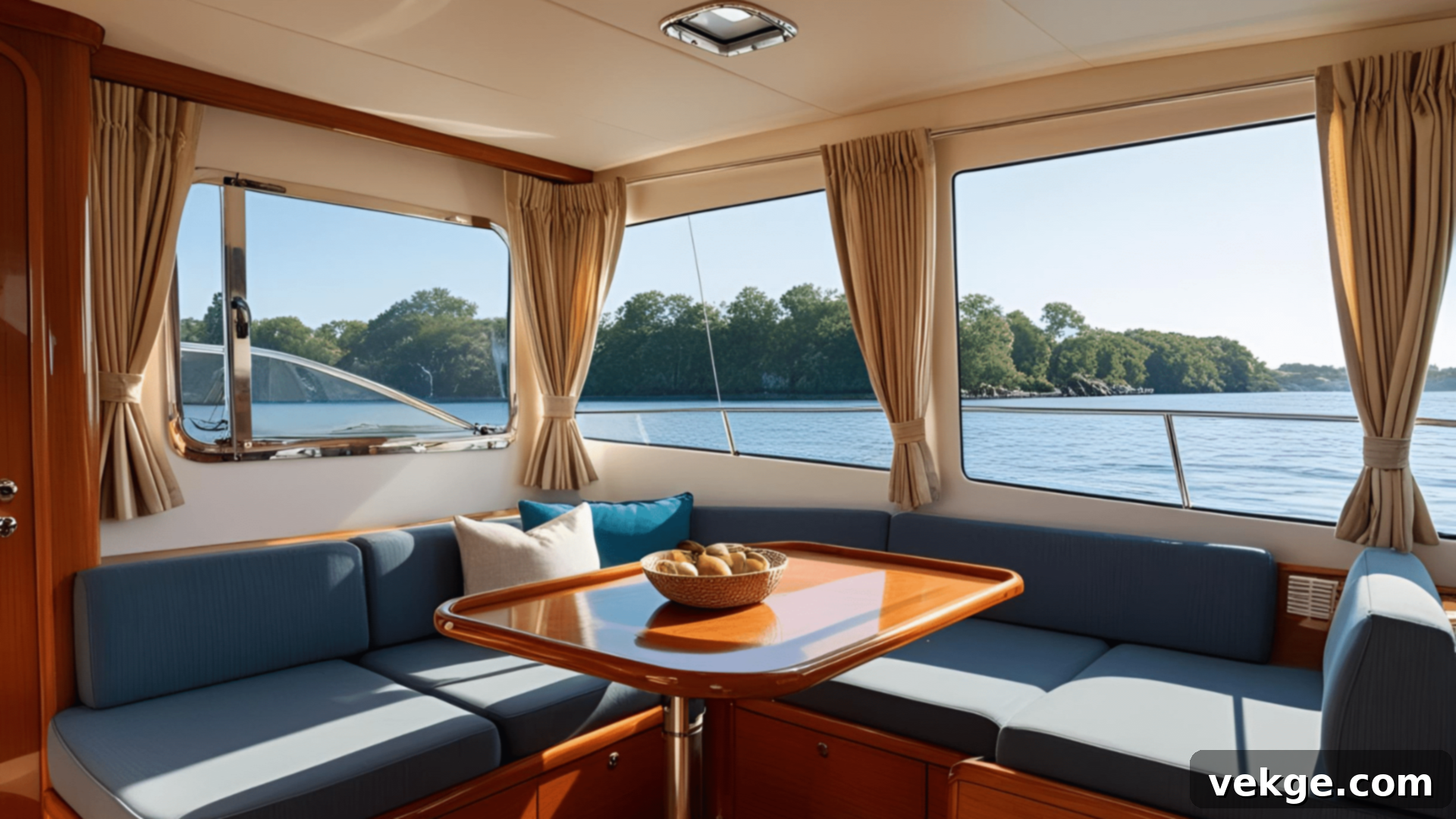
Heavy or bulky curtains can block precious natural light and visually shrink windows, making a boat interior feel enclosed. Where privacy isn’t a paramount concern, consider ditching curtains altogether to maximize window space and allow unobstructed views. This creates a seamless connection with the outside world, bringing the expansive marine environment directly into the cabin. If privacy or light control is needed, opt for lightweight, sheer blinds, minimal roller shades, or simple, light-colored fabric panels that can be easily pulled back or tucked away. The goal is to maximize natural light and maintain an open sightline.
- Why it Works: Unobstructed windows allow maximum natural light to flood the space and remove visual barriers, expanding the interior by connecting it to the exterior environment.
- How to Implement: Remove heavy curtains. If privacy is a concern, replace them with lightweight, light-filtering blinds, cellular shades, or simple, unobtrusive Roman shades. Use clear glass where possible.
- Best For: Boats with expansive windows, stunning views, or those seeking to maximize natural light and connection to the outdoors.
9. Hang a Statement Mirror
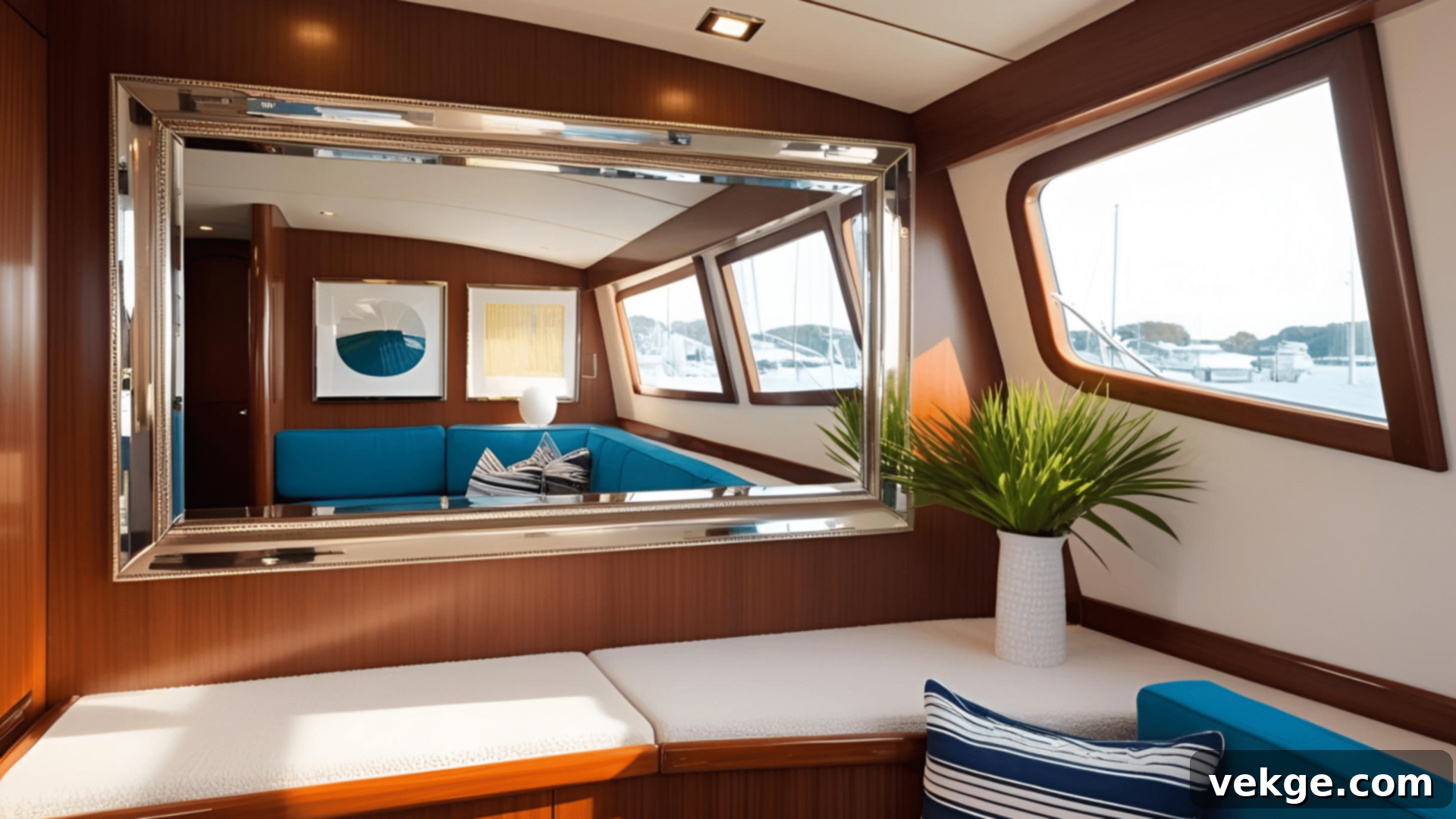
Mirrors are a classic interior design trick for making small spaces appear larger, and they work exceptionally well in boat interiors. Using a large mirror as a statement piece or strategically placing several smaller mirrors can create incredible depth and amplify light. Reflective surfaces bounce natural and artificial light around the room, instantly making the interior feel brighter and visually expanding the space. Position a mirror opposite a window or a light source to maximize its effect, essentially doubling the light and the view. This creates a powerful illusion of more square footage.
- Why it Works: Mirrors are masters of illusion; they reflect light and create the visual impression of an extended room, adding significant depth and brightness.
- How to Implement: Hang a large, stylish mirror on a prominent wall. Consider mirrored panels on cabinet doors or a mirrored backsplash in the galley. Ensure mirrors are securely mounted for safety at sea.
- Best For: Small, dark spaces that need a significant boost in brightness, depth, and visual intrigue.
Updating Your Boat Interior: Easy Steps for a Fresh Look
Refreshing your boat’s interior can dramatically enhance its look and feel, making it more comfortable, modern, and visually appealing. Whether you’re planning small, targeted updates or contemplating a full renovation, a thoughtful and systematic approach ensures the best results. From selecting appropriate colors and materials to optimizing storage and lighting, each step contributes to creating a space that feels open, inviting, and highly functional for life on the water.
Assessing Your Space
Before diving into any changes, take the time to thoroughly evaluate your boat’s current layout, existing light sources, and any problem areas. Walk through each section of the cabin and identify spaces that feel particularly cramped, dark, or disorganized. Consider the primary function of each area—galley, sleeping quarters, salon—and how effectively it currently serves its purpose. Also, pay attention to the flow between different rooms. This initial assessment will help you prioritize updates that will make the most significant impact on both usability and aesthetics, ensuring your efforts are well-directed.
Setting a Realistic Budget
Establishing a clear and realistic budget is a critical step in any boat interior update project. Determine which upgrades are most important to you and where you want to allocate your funds. Break down potential expenses into categories, including material costs (paint, fabric, hardware), labor fees if hiring professionals, and a contingency fund for unexpected expenses (which are common in marine projects). Knowing your financial limits upfront will empower you to make informed decisions, explore cost-effective alternatives, and invest in the improvements that offer the most value and impact within your means.
DIY vs. Professional Work
Deciding which tasks to tackle yourself and which to entrust to professionals is a key consideration. Many projects, such as painting, installing simple storage solutions, or updating soft furnishings, can be successfully handled as DIY projects, offering cost savings and a sense of accomplishment. However, other tasks, such as complex electrical work, plumbing modifications, structural changes, or intricate upholstery, often require specialized skills and tools. Be honest about your own skillset and comfort level to avoid costly mistakes or safety hazards. A balanced approach, combining your DIY efforts with expert help for more complex jobs, ensures both quality craftsmanship and cost efficiency in your boat renovation.
Maintaining Your Boat’s New Look

Once you’ve invested time and effort into transforming your boat’s interior, ongoing maintenance is crucial to preserving its fresh, spacious, and inviting atmosphere. A clean and well-maintained boat not only looks better but also contributes to a more pleasant and healthy environment onboard.
Daily Tidying Tips
Preventing clutter from accumulating is vital to maintaining the open feel of your boat. Make a habit of daily tidying: after each use, return items to their designated places. Utilize all your smart storage solutions effectively, and regularly assess your boat’s interior for any unnecessary items that have crept in. A quick daily wipe-down of surfaces, especially in the galley and head, can prevent grime buildup. Consistent upkeep will ensure that your organized, spacious atmosphere remains intact, making your boat a more relaxing sanctuary.
Cleaning and Care Routines
Regular and appropriate cleaning is essential, especially for light-colored surfaces and fabrics that tend to show dirt more readily. Use gentle, non-abrasive, marine-grade cleaners on walls, upholstery, fixtures, and countertops to avoid damage. Vacuum or wipe down all surfaces frequently to prevent dust and dirt buildup, which can dull finishes and make a space feel less clean. For fabrics, consider using appropriate fabric protectors to guard against stains, and address spills immediately. Regular cleaning not only preserves the aesthetic but also extends the life of your interior components.
Effective Ventilation Practices
Proper ventilation is paramount in a marine environment to ensure your boat remains fresh, free of stale odors, and, most importantly, free of moisture issues. Stagnant air can lead to mildew, mold growth, and a damp, unpleasant feel that undermines all your efforts to create a light and airy space. Open windows, hatches, and portholes whenever weather permits to allow fresh air to circulate. Utilize built-in vents, and consider investing in small, energy-efficient fans or a marine dehumidifier to improve airflow and reduce humidity, especially in damp climates or during periods of non-use. Adequate ventilation helps preserve the integrity of all your interior materials and keeps the atmosphere crisp and dry.
Common Mistakes to Avoid When Designing Your Boat Interior
While the goal is to create a spacious and light boat interior, certain design pitfalls can inadvertently undermine your efforts. Being aware of these common mistakes will help you make more effective choices and ensure your renovation truly delivers the desired outcome.
Overcrowding with Storage Solutions
While having ample storage options is undeniably essential in a boat, it’s possible to have too much of a good thing. Overpacking every available nook and cranny with storage units can paradoxically create a cluttered and heavy feel, defeating the very purpose of trying to increase space. Ensure that you only store what is truly necessary for your voyages and lifestyle. Leave some open areas—a clear countertop, an empty corner—to maintain visual breathing room and a genuine spacious vibe. Sometimes, less is indeed more.
Choosing the Wrong Color Palette
Opting for a color scheme that is too dark, too vibrant, or heavily contrasting can make your boat interior feel even smaller, busier, and more enclosed than before. Dark colors absorb light, while jarring contrasts can visually chop up the space and create a sense of chaos. Instead, always gravitate towards light, neutral tones, and cohesive color combinations that reflect light and promote a seamless, expansive feel. Soft whites, gentle grays, and subtle pastels are your best allies.
Poor Lighting Placement or Type
Overlooking the strategic placement of lighting fixtures or relying on harsh, single-source lighting can leave your spaces feeling cramped, shadowy, or uncomfortable. A single overhead light, for instance, can create unflattering shadows and fail to illuminate corners effectively. Always opt for layered lighting that combines ambient, task, and accent lighting. Utilize dimmable LEDs to control intensity and color temperature, and consciously make use of natural light sources. Thoughtful lighting can visually lift ceilings, open up dark areas, and greatly enhance the openness of your boat.
Ignoring Fabric Choices
Using heavy, dark, or overly patterned fabrics for upholstery, curtains, or bedding can quickly close off your boat’s interior, absorbing light and creating a bulky appearance. These choices can make a small cabin feel even more diminutive and oppressive. To maintain a light and airy feel, avoid heavy upholstery and fabrics that absorb light. Instead, opt for lighter tones, sheer materials, and subtly textured fabrics that help brighten the space, reflect light, and contribute to an open, flowing aesthetic.
Forgetting to Use Reflective Surfaces
Failing to incorporate reflective surfaces like mirrors, glass, or glossy finishes is a missed opportunity to expand the sense of space in a boat. Without these elements, a space can feel flat and one-dimensional. Mirrors, in particular, are incredibly powerful tools for reflecting light and creating the illusion of depth and an expanded view. Use a large, well-placed statement mirror, consider mirrored accents on furniture, or opt for subtle glossy finishes on surfaces to enhance depth, multiply light, and visually open up the interior.
Conclusion
Transforming your boat interior to feel lighter and more spacious offers a multitude of benefits, including significantly improved livability, enhanced natural light, and a much more inviting and comfortable atmosphere. By implementing simple yet remarkably effective changes—such as diligently organizing clutter, embracing light color schemes, optimizing both natural and artificial lighting, and carefully selecting materials—you can effortlessly create a boat interior that not only feels open and airy but truly reflects your desire for a serene marine retreat.
Remember, these design principles and practical suggestions are highly adaptable and can be tailored to fit the specific needs and dimensions of your vessel, whether you own a compact cabin cruiser or a larger yacht. Don’t hesitate to experiment with the suggestions that best suit your boat’s unique character and your personal style, always striving for a harmonious balance between aesthetic appeal and practical functionality.
Ultimately, a well-designed and maintained boat interior contributes immensely to the joy of boating. By focusing on creating a comfortable, open, and visually appealing space, you ensure that every moment spent aboard is a truly enjoyable and relaxing experience, allowing you to fully embrace the freedom and beauty of life on the water.
